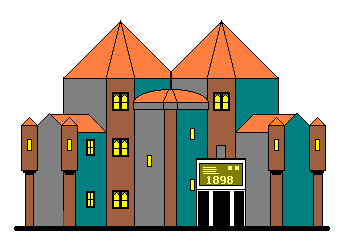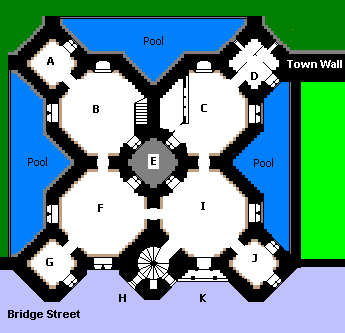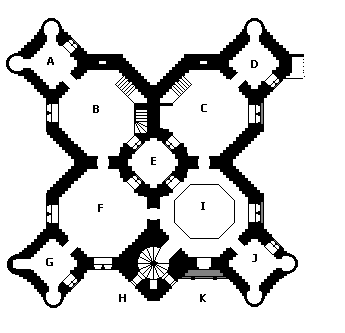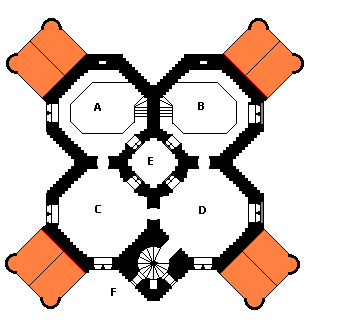Honeycomb Tower

At the northwest corner of the town of Farnisham, there is a peculiar building, now the Isle of Farnish Museum of Arts and History and Public Library. It is situated on the site of one of the medieval corner towers of the town wall (which still exists here on the north side of Frarnisham, although it has mostly disappeared in the rest of the town); it faces onto Bridge Street, which is the northern bridge leading to the cemetery and Gelling Road. This was built in 1898 by Jesse McBride, a rich diamond mine owner from South Africa who had been born in Farnisham; he fancied himself another Andrew Carnegie in his old age, hence this structure, which was built for the purpose it still serves.
This is by far the largest building in the town, although not large by 'Natural History Museum' standards. It gets its name because it consists of four hexagonal towers arranged in a honeycomb pattern. There are four square corner towers, a stair tower next to the porched entrance, and a central (and very small and dim) light well; there is also a 'moat', or actually three fishponds. It is the four main towers that are most striking to the eye. Sixty feet tall and steepled. (Note: there were many gargoyles and pinnacles atop the building, but they were removed in the 1960s during a period of governmental stupidity; some of them are now exhibited within the museum.)

Ground Floor
No, you are not going blind, it's just the way the image is shaded to represent plinths and woodwork. |
- A) Librarian's Office
- B) Reading Room
- C) Tea Room
- D) Lavatories
- E) Courtyard (light well)
- F) Catalogue Room
- G) Staff Room
- H) Stair tower
- I) Foyer (and Armorial Gallery -- two stories)
- J) Cloakroom
- K) Entrance
|

First Floor
Those round things at the corners are turret windows. |
- A) 'Scholar's Study'
- B) Library Stacks (2 stories)
- C) Painting Gellery (2 stories)
- D) Religious Art
- E) Courtyard (light well)
- F) Library Stacks
- G) Rare Books
- H) Stair tower
- I) Upper part of Foyer (Portraits)
- J) Curator's Office
- K) Balcony
|

Second Floor
Orange stuff represents roofs of the corner wings. |
- A) Upper Stacks
- B) Upper Art Gallery
- C) Local History
- D) Natural History
- E) Courtyard (light well)
- F) Stair Tower
|
Below Castle Hill, in the town of Farnisham itself, is the Tower.
To the east of the Museum is Castle Hill, atop which is Farnisham Castle and to the south is the Bastle or Town Hall.



|